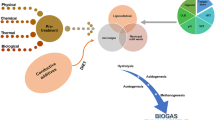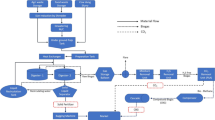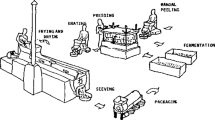Abstract
The development of biofuels to replace fossil fuels with bioenergy systems has attracted attention as an environmental-friendly process. Dealing with biowaste by anaerobic digestion disposes of wastes and produces biogas during the treatment processes for providing the renewable energy source at a low cost while conserving fossil fuel. This study uses life cycle assessment and cost-benefit analysis to evaluate and compare environmental impacts and cost benefits before and after installing a rapid-build anaerobic fermentor module into the three-stage wastewater treatment system that the swine farm initially used. The module helps biogas production as energy recovery in swine farms. The results indicate that the module could help reduce carbon footprint by 22.6%, methane by 51.8%, sulfur oxides by 92.6%, nitrogen oxides by 74.2%, carbon monoxide by 54.7%, nitrous oxide by 28.6%, suspended particulate by 95.4%, and non-methane volatile organic compounds by 80%. Using this module made the reductions of damage impacts were human health 82%, ecosystem quality 59%, and resource scarcity 87%. The daily average biogas production was 46.38 m3, and its annual electricity generation income was 6091 USD. This study allows identifying the lowest environmental impact to support the adoption of sustainable waste treatment and the opportunity for converting waste to be energy and utilization with economic benefits for small-scale swine farms.
Graphic abstract







Similar content being viewed by others
References
Abdelsalam E, Hijazi O, Samer M, Yacoub IH, Ali AS, Ahmed RH, Bernhardt H (2019) Life cycle assessment of the use of laser radiation in biogas production from anaerobic digestion of manure. Renew Energy 142:130–136. https://doi.org/10.1016/j.renene.2019.04.090
Adeoti O, Ayelegun TA, Osho SO (2014) Nigeria biogas potential from livestock manure and its estimated climate value. Renew Sustain Energy Rev 37:243–248. https://doi.org/10.1016/j.rser.2014.05.005
Alfa MI, Owamah HI, Onokwai AO, Onokwai AO, Gopikumar S, Oyebisi SO, Kumar SS, Bajar S, Samuel OD, Ilabor SC (2020) Evaluation of biogas yield and kinetics from the anaerobic co-digestion of cow dung and horse dung: a strategy for sustainable management of livestock manure. Energy Ecol Environ. https://doi.org/10.1007/s40974-020-00203-0
Bernstad A, la Cour Jansen J (2011) A life cycle approach to the management of household food waste—A Swedish full-scale case study. Waste Manag 31:1879–1896. https://doi.org/10.1016/j.wasman.2011.02.026
Börjesson P, Berglund M (2006) Environmental systems analysis of biogas systems—Part I: Fuel-cycle emissions. Biomass Bioenerg 30:469–485. https://doi.org/10.1016/j.biombioe.2005.11.014
Bui XT, Wolff A, Madsen M, Bang DD (2011) Fate and survival of campylobacter coli in swine manure at various temperatures. Front Microbiol 2:262. https://doi.org/10.3389/fmicb.2011.00262
Cantrell KB, Ducey TF, Ro KS, Hunt PG (2008) Livestock waste-to-bioenergy generation opportunities. Biores Technol 99:7941–7953. https://doi.org/10.1016/j.biortech.2008.02.061
Choudhary A, Kumar A, Kumar S (2020) Techno-economic analysis, kinetics, global warming potential comparison and optimization of a pilot-scale unheated semi-continuous anaerobic reactor in a hilly area: For north Indian hilly states. Renewable Energy 155:1181–1190. https://doi.org/10.1016/j.renene.2020.04.034
Chinese Petroleum Corporation (CPC Corporation) (2020) Historical natural gas price. Taiwan, ROC https://vipmember.tmtd.cpc.com.tw/mbwebs/ShowHistoryPrice_8.aspx
Council of Agriculture (Taiwan COA) (2010) Animal Industry Act. Executive Yuan, Taiwan, ROC
Council of Agriculture (Taiwan COA) (2016) Pig farms biogas power generation development plan. Executive Yuan, Taiwan, ROC
Deng S, Wang RZ, Dai YJ (2014) How to evaluate performance of net zero energy building—a literature research. Energy 71:1–16. https://doi.org/10.1016/j.energy.2014.05.007
Dourmad JY, Sève B, Latimier P, Boisen S, Fernandez J, Van der Peet-Schwering C, Jongbloed AW (1999) Nitrogen consumption, utilisation and losses in pig production in France, the Netherlands and Denmark. Livest Prod Sci 58:261–264. https://doi.org/10.1016/S0301-6226(99)00015-9
Ducat DC, Silver PA (2012) Improving carbon fixation pathways. Curr Opin Chem Biol 16:337–344. https://doi.org/10.1016/j.cbpa.2012.05.002
Environmental Protection Administration (Taiwan EPA) (2018) Water Pollution Control Act. Executive Yuen, Taiwan, ROC
Food and Agriculture Organization (FAO) (2020) Major cuts of greenhouse gas emissions from livestock within reach: GHG emissions by livestock. United Nations http://www.fao.org/news/story/en/item/197623/icode/
Godbout S, Pelletier FP, Hamelin L, Lemay SP, Belzile M, Laverdière MR, Côté C, Giroux M, Pouliot F, Quessy S (2008) Problématiques environnementales émergentes en production animale. IRDA-CRAAQ, Quebec, pp 45–60
Grossi G, Goglio P, Vitali A, Williams AG (2018) Livestock and climate change: impact of livestock on climate and mitigation strategies. Animal Front 9:69–76. https://doi.org/10.1093/af/vfy034
Guinée JB, Gorrée M, Heijungs R, Huppes G, Kleijn R, de Koning A, van Oers L, Wegener Sleeswijk A, Suh S, Udo de Haes HA, de Bruijn H, van Duin R, Huijbregts MAJ (2002) Handbook on life cycle assessment, operational guide to the ISO standards, Part III: Scientific background. Kluwer Academic Publishers, Dordrecht, pp 401–644
Hellweg S, Mila i Canals L (2014) Emerging approaches, challenges and opportunities in life cycle assessment. Science 344:1109–1113. https://doi.org/10.1126/science.1248361
Huijbregts MAJ, Steinmann ZJN, Elshout PMF, Stam G, Verones F, Vieira MDM, Hollander A, Zijp M, van Zelm R (2017) ReCiPe2016: a harmonized life cycle impact assessment method at midpoint and endpoint level. Int J Life Cycle Assess 22:138–147. https://doi.org/10.1007/s11367-016-1246-y
International Organization for Standardization (ISO) (2006) Environmental management-life cycle assessment-principles and framework, ISO 14040-14044:2006(en). Geneva, Switzerland
International Organization for Standardization (ISO) (2018) Greenhouse gases - carbon footprint of products—requirements and guidelines for quantification, ISO 14067:2018(en). Geneva, Switzerland
IPCC (2013) The Physical science basis. Contribution of working group I to the fifth assessment report of the intergovernmental panel on climate change. In: Stocker TF, Qin D, Plattner G-K, Tignor M, Allen SK, Boschung J, Nauels A, Xia Y, Bex V, Midgley PM (eds) Climate change 2013. Cambridge University Press, Cambridge, p 1535
Ishikawa S, Hoshiba S, Hinata T, Hishinuma T, Morita S (2006) Evaluation of a biogas plant from life cycle assessment (LCA). Int Congr Ser 1293:230–233. https://doi.org/10.1016/j.ics.2006.02.008
Mabee WE, Saddler JN (2010) Bioethanol from lignocellulosics: status and perspectives in Canada. Biores Technol 101:4806–4813. https://doi.org/10.1016/j.biortech.2009.10.098
Nasir IM, Ghazi TIM, Omar R (2012) Anaerobic digestion technology in livestock manure treatment for biogas production: A review. Eng Life Sci 12:258–269. https://doi.org/10.1002/elsc.201100150
Petersson A, Wellinger A (2009) Biogas upgrading technologies–developments and innovations. IEA Bioenergy Technology Collaboration Programme (TCP), p 19
Roubík H, Mazancová J (2020) Suitability of small-scale biogas systems based on livestock manure for the rural areas of Sumatra. Environ Dev 33:100505. https://doi.org/10.1016/j.envdev.2020.100505
SimaPro v.8.4 software (2017) PRè Sustainability Consultant: Amersfoort, the Netherlands
Tsai WT (2018) Regulatory promotion and benefit analysis of biogas-power and biogas-digestate from anaerobic digestion in Taiwan’s livestock industry. Fermentation 4(3):57. https://doi.org/10.3390/fermentation4030057
Tsai W-T, Lin C-I (2009) Overview analysis of bioenergy from livestock manure management in Taiwan. Renew Sustain Energy Rev 13:2682–2688. https://doi.org/10.1016/j.rser.2009.06.018
Usack JG, Gerber Van Doren L, Posmanik R, Labatut RA, Tester JW, Angenent LT (2018) An evaluation of anaerobic co-digestion implementation on New York State dairy farms using an environmental and economic life-cycle framework. Appl Energy 211:28–40. https://doi.org/10.1016/j.apenergy.2017.11.032
Weidema BP, Bauer C, Hischier R, Mutel C, Nemecek T, Reinhard J, Vadenbo CO, Wernet G (2013) Overview and methodology. Data quality guideline for the ecoinvent database version 3. Ecoinvent Report 1(v3). St. Gallen: The ecoinvent Centre
Acknowledgements
The authors deeply appreciate the financial supports from the Ministry of Science and Technology, Taiwan (MOST 108-2221-E-035-036-MY3 and MOST 109-2221-E-035-028). An appreciation of the swine manure, sewage feedstocks, and energy data in the swine husbandry provided by the pig farms in Dali, Taichung, Taiwan was also acknowledged.
Author information
Authors and Affiliations
Corresponding author
Ethics declarations
Conflict of interest
There is no conflict of interest to claim in this study.
Additional information
Publisher's Note
Springer Nature remains neutral with regard to jurisdictional claims in published maps and institutional affiliations.
Rights and permissions
About this article
Cite this article
Shih, MF., Lay, CH., Lin, CY. et al. Exploring the environmental and economic potential for biogas production from swine manure wastewater by life cycle assessment. Clean Techn Environ Policy 25, 451–464 (2023). https://doi.org/10.1007/s10098-021-02157-1
Received:
Accepted:
Published:
Issue Date:
DOI: https://doi.org/10.1007/s10098-021-02157-1




